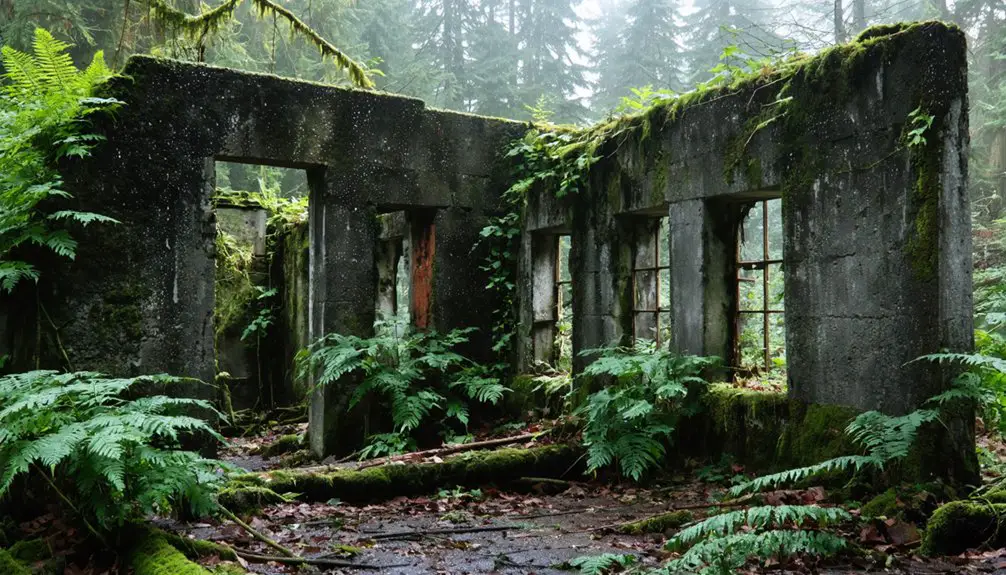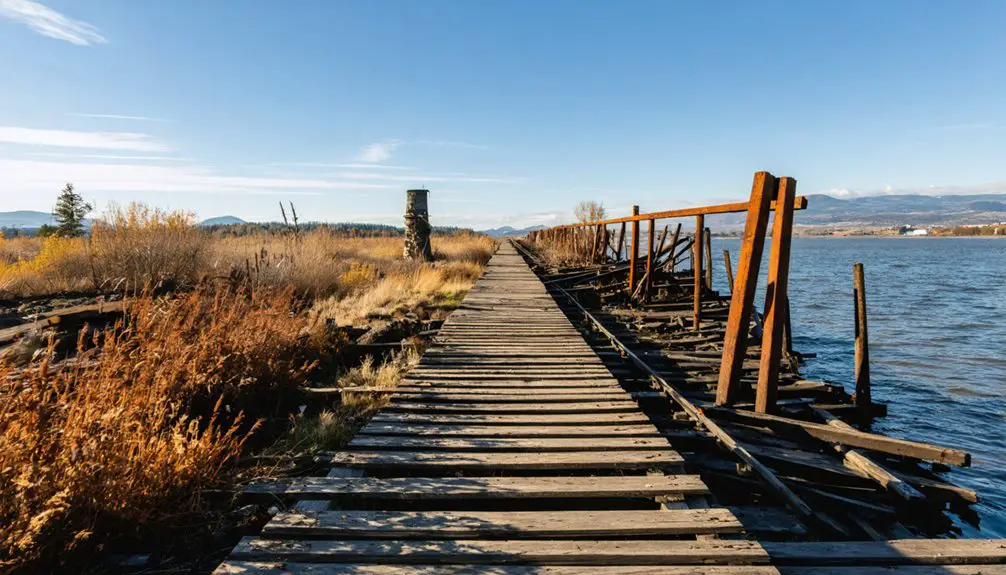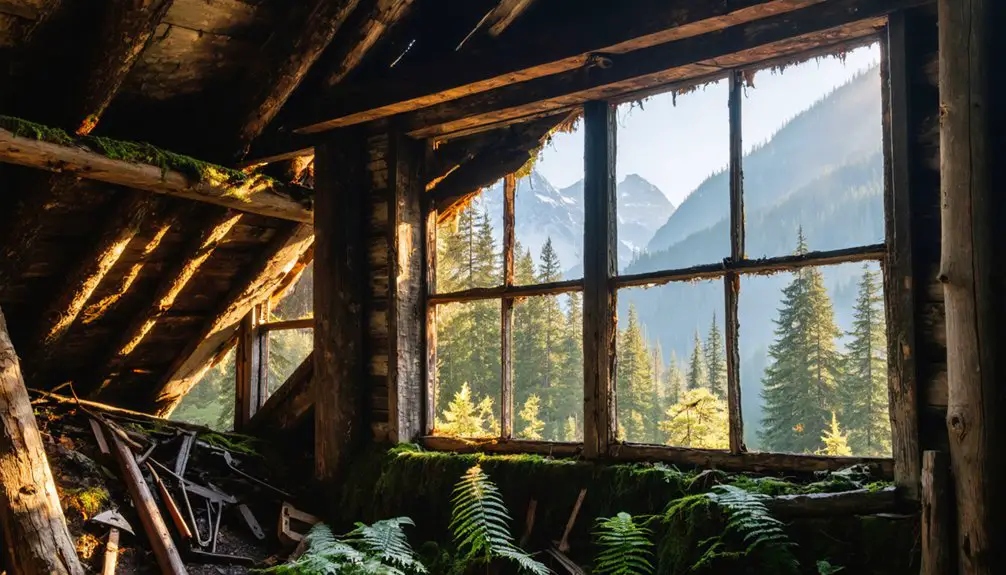You’ll find Melmont’s ghostly remnants along the Carbon River in Pierce County, Washington. This former coal mining town, established in 1900 by Northwest Improvement Company, thrived for 16 years and extracted 900,000 tons of coal through six underground levels. Today, you can explore moss-covered retaining walls, a dynamite storage shed, and scattered foundations of the schoolhouse and hotel complex. The town’s fascinating story of rise and decline reveals deeper layers beneath its ruins.
Key Takeaways
- Melmont was a coal mining town established in 1900 by Northwest Improvement Company, operating for 16 years before its abandonment.
- The town produced 900,000 tons of coal through six underground levels, contributing 4% to Pierce County’s coal production.
- Diesel engines replaced steam locomotives in the 1920s, making Melmont’s coal operations obsolete and leading to its desertion.
- A forest fire destroyed most remaining structures, though visitors can still find remnants like a retaining wall and dynamite shed.
- Located near Carbonado, the ghost town’s ruins can be explored via an abandoned rail bed trail through surrounding forest.
The Birth of a Company Town
In 1900, the Northwest Improvement Company, a subsidiary of Northern Pacific Railway, established Melmont as a purpose-built settlement to support their coal mining operations. The company’s influence extended far beyond the mines, as they exercised complete company ownership over the town’s essential infrastructure, including the hotel, saloon, schoolhouse, and train depot.
You’d have found the town strategically positioned between the Carbon River and the Northern Pacific Railroad line, optimizing coal transport logistics. The social dynamics reflected the company’s organizational philosophy, with miners’ cottages arranged in distinct sections based on nationality. By the time operations ceased in 1918, the mine had produced 900,000 tons of coal.
A bridge spanning the Carbon River connected the company hotel and saloon to nearby mining communities, while the hotel complex served multiple functions, housing the post office, butcher shop, and store under one company-controlled roof. By 1915, the post office had ceased operations, marking the beginning of the town’s decline.
Coal Mining Operations and Economic Growth
While Melmont’s coal mining operations lasted only 16 years, they proved remarkably productive during their brief run. You’ll find the numbers impressive: miners extracted roughly 900,000 tons of coal, averaging 750 tons daily through six underground levels that reached depths of 600 feet.
The mining technology of the era allowed workers to tap into valuable deposits of high-grade blacksmith coal. Miners used advanced methods like drift and pillar systems to extract coal efficiently.
Labor movements gained traction as miners organized under United Mine Workers local #2963. The Northwest Improvement Company, a Northern Pacific Railway subsidiary, initially managed operations until 1918, followed briefly by the Carbon Hill Coal Company.
Miners found strength in numbers, organizing under UMW #2963 while Northwest Improvement Company and later Carbon Hill Coal managed operations.
The town’s strategic location near rail lines enabled efficient transport, with coal traveling 3 miles to Carbonado for processing. Though Melmont contributed just 4% of Pierce County’s coal production, it profoundly shaped the region’s industrial landscape.
Daily Life in Early Melmont
If you’d lived in early Melmont, you’d have found your daily routine shaped by the demanding schedules of coal mining, with families organizing their lives around the mine’s operations and six underground levels.
You would’ve noticed distinct ethnic divisions reflected in the town’s segregated housing layout, where miners of similar nationalities lived together in designated rows of cottages.
Your social interactions would’ve centered around communal spaces like the multipurpose hotel and saloon, though these gatherings likely remained influenced by the ethnic groupings that characterized Melmont’s residential arrangement.
Mining Family Routines
Life for mining families in early Melmont revolved around the demanding schedules of coal extraction, with miners enduring 8 to 12-hour shifts at depths reaching 600 feet underground.
You’d find family dynamics shaped by the industry’s relentless pace, as household members adapted to support the miners’ grueling work schedules.
The daily challenges were constant – you’d wake to the sounds of shift changes while managing a household in company-provided cottages, where ethnic groups typically clustered in distinct rows.
You’d coordinate meals around the mine’s strict timetables, shop at the company store, and gather with neighbors at the hotel’s post office.
Your children would attend the hillside schoolhouse while you’d tend to manual household tasks, all while maintaining strong community bonds despite the town’s isolated location near the Carbon River valley.
Social Structure and Segregation
Though Melmont’s residents shared the common identity of coal mining, you’d find their social structure strictly divided along ethnic lines, most visibly through the company’s segregated housing arrangement.
You’d notice rows of cottages grouped by nationality, creating distinct ethnic enclaves that reinforced cultural and linguistic boundaries.
Despite this physical separation, you could witness moments of cross-cultural interaction in the town’s shared spaces.
The saloon, hotel, and schoolhouse served as gathering points where social tensions occasionally eased. Children from different backgrounds mingled in the schoolhouse, while adults converged at the hotel and saloon.
However, the Northwest Improvement Company‘s control over housing and facilities maintained this segregated social order, which simplified their management of a diverse workforce while limiting residents’ personal autonomy.
The Cultural Mosaic of Mining Families
While many early 20th century mining towns featured diverse immigrant populations, Melmont’s distinct organization of housing by nationality created a unique cultural tapestry within the community.
You’d find vibrant displays of cultural preservation as ethnic groups maintained their traditions, languages, and customs within their designated rows of miner cottages.
The town’s cultural mosaic was evident through:
- Family-centered community celebrations reflecting specific ethnic heritages
- Religious and cultural societies providing mutual support networks
- Shared social spaces like saloons and the post office fostering cross-cultural interactions
- Children’s education at the company school, where diverse backgrounds merged
Despite physical segregation in housing, miners united through their shared occupation, creating bonds that transcended ethnic divisions while preserving their unique cultural identities.
Railroad’s Influence on Town Development
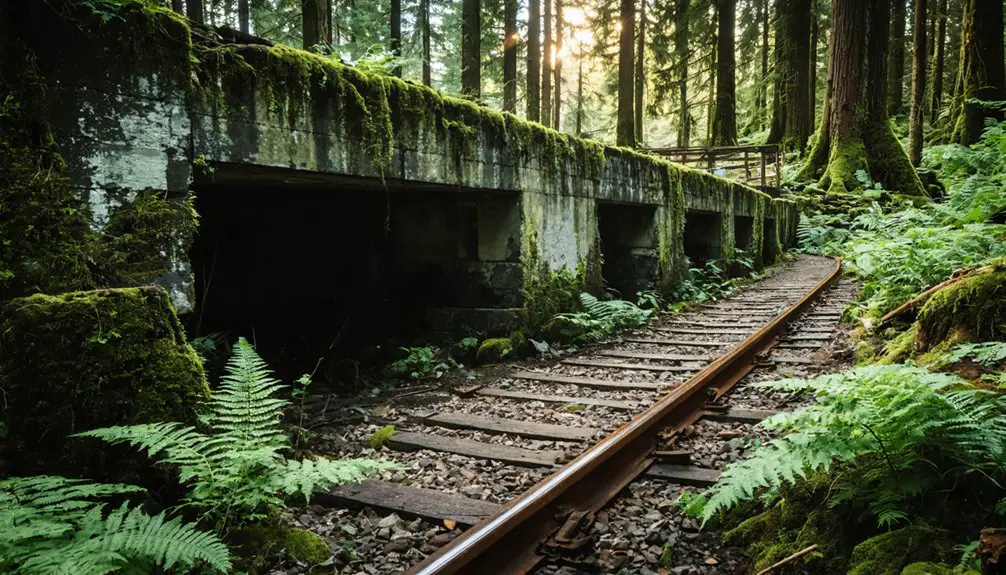
If you’d explored Melmont in its heyday, you would’ve seen how the Northern Pacific Railway‘s infrastructure dominated the town’s development through its subsidiary, the Northwest Improvement Company.
The railway company’s strategic placement of the train depot, coal storage facilities, and transport lines shaped Melmont’s layout, with essential buildings and miners’ homes clustered around the tracks. Like the Chinese laborers built many railways in the region, these tracks were vital infrastructure that determined how the town grew and functioned.
You can still spot remnants of this railroad-centric design today in the surviving retaining wall and building foundations that once served as the town’s transportation hub for shipping 750 tons of coal daily.
Railroad Infrastructure Development
As a strategic initiative by the Northwest Improvement Company, Melmont’s founding in 1900 exemplified how railroad companies shaped frontier town development in the early 20th century.
Similar to the Central Washington Railway in Govan, the Northern Pacific Railway’s subsidiary designed the town’s infrastructure for maximum transportation efficiency and railroad expansion. The coal mining operations exclusively supplied fuel for Northern Pacific’s locomotives until technological changes rendered coal obsolete.
The town’s crucial railroad infrastructure included:
- A strategically positioned railroad depot on the hillside, optimizing coal loading operations
- A significant railroad bridge spanning the Carbon River, connecting the town’s key structures
- Carefully planned rail lines facilitating direct coal shipment to Northern Pacific
- Worker housing and commercial buildings positioned near rail infrastructure
This thorough rail-centric design guaranteed seamless integration between the town’s mining operations and Northern Pacific’s transportation network, though it ultimately made Melmont vulnerable to technological changes in locomotive fuel.
Northern Pacific’s Economic Control
Because Northern Pacific Railway controlled Melmont’s coal supply chain through its subsidiary Northwest Improvement Company, the railroad exercised complete economic dominion over the town’s development and survival.
You’ll find that Northern Pacific’s grip extended far beyond just mining operations – they orchestrated every aspect of daily life through strategic economic control.
The railroad’s economic dependency model meant you couldn’t escape their influence. They segregated worker housing by nationality, controlled the local businesses, and served as the sole employer in town. Following the pattern of Skookum Smith’s tactics, the railroad strategically directed development to maximize control over valuable natural resources.
These calculated labor dynamics guaranteed Northern Pacific maintained absolute power over the workforce. When the railroad switched from steam to diesel locomotives, they simply shut down operations, demonstrating how their corporate decisions could instantly transform a thriving town into a ghost town.
Transportation Hub Evolution
While steam locomotives fueled Melmont’s early growth, the town’s evolution as a transportation hub centered entirely around the Northern Pacific Railroad‘s expanding coal operations.
The railroad logistics shaped every aspect of Melmont’s development, from its strategic location to its daily operations.
You’ll find the transportation evolution reflected in these key developments:
- The railroad enabled massive coal shipments, averaging 750 tons daily
- An essential railroad bridge across Carbon River connected crucial facilities
- The depot became the heart of the town, attracting businesses and families
- Rail lines linked Melmont to neighboring towns like Fairfax and Carbonado
When diesel engines replaced steam locomotives, Melmont’s role as a transportation hub became obsolete, leading to its eventual abandonment by the early 1920s.
The Era of Decline
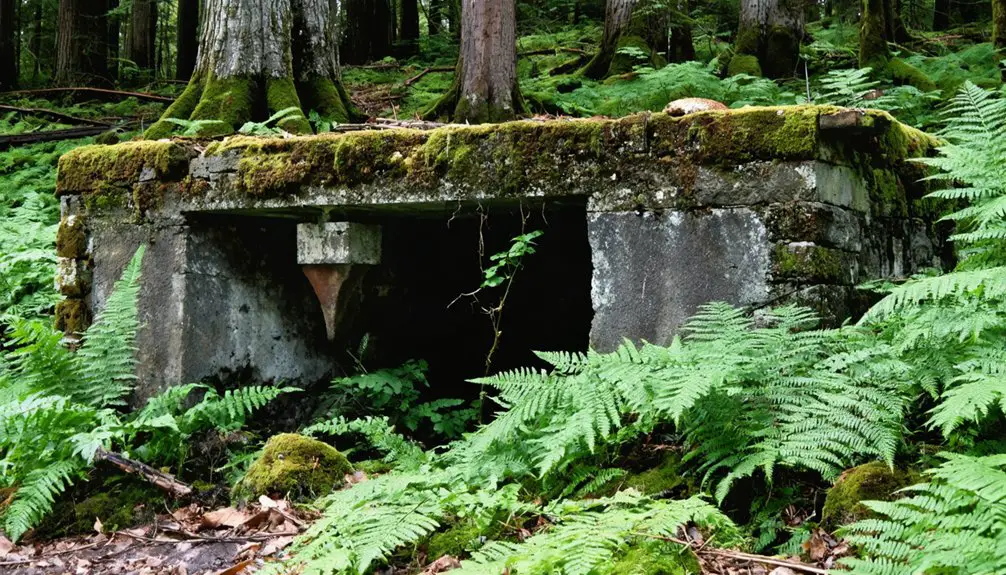
Once the Northern Pacific Railway shifted from steam to diesel and electric locomotives in the early 1920s, Melmont’s fate was sealed.
The economic repercussions were devastating as coal demand plummeted, forcing the Northwest Improvement Company to cease mining operations.
You’d have witnessed dramatic demographic shifts as miners and their families abandoned their ethnically-segregated housing rows in search of work elsewhere.
Coal price fluctuations in the 1910s and 1920s only hastened the town’s demise, making mining operations financially unsustainable.
By 1915, the post office had already closed, signaling the beginning of the end.
A forest fire dealt the final blow, destroying most remaining structures.
Today, you’ll find only ruins of foundational walls and a lone dynamite shed where this once-bustling mining town stood.
The tension in the community had already been evident years earlier when a bombing in 1905 targeted the mine owner’s residence.
What Remains Today
Today’s visitors to Melmont will find scattered remnants of this once-thriving mining community along an abandoned rail grade south of Carbonado.
The most prominent structural remains include a moss-covered retaining wall and the stone walls of an old dynamite storage shed. You’ll discover foundations of the former schoolhouse and hotel complex while exploring the site’s trails.
Key features you’ll encounter:
- A visible trail following the abandoned rail bed, now surrounded by mossy forest growth
- The open townsite field containing various building foundations
- An old wagon bridge abutment marking former transportation routes
- Views of the Carbon River valley from several vantage points
While many wooden structures have deteriorated, the remaining artifacts and foundations provide fascinating glimpses into Melmont’s mining past.
Exploring the Ghost Town
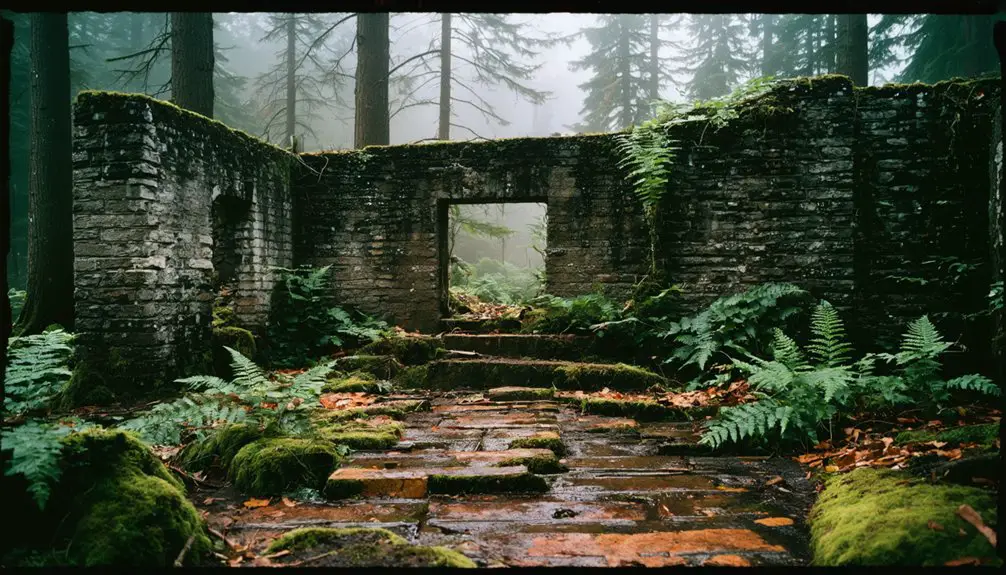
Located between Carbonado and Fairfax in Pierce County, Washington, Melmont offers an engaging hiking experience through a historic ghost town site.
Step into Washington’s past as you explore Melmont, a captivating ghost town nestled in Pierce County’s forested landscape.
You’ll find the best access along the old railroad grade via the Fairfax Bridge, which holds a spot on the National Register of Historic Places.
For ideal ghost town exploration, plan your visit during spring, fall, or winter when vegetation is less dense.
You’ll discover remnants along the Carbon River trails, where filtered forest light creates an atmospheric setting.
While most wooden structures were lost to a 1920s fire, you can still spot various foundations beneath the forest canopy.
The coordinates 47.0709°N, -122.0410°W and 47.0573°N, -122.0415°W will help guide your journey through this fascinating piece of mining history.
The town once thrived as a hub for coal production from 1902 to 1918.
Historical Legacy and Preservation
While the physical remnants of Melmont invite exploration, the town’s deeper significance lies in its historical legacy as a Northern Pacific Railway company town.
The community dynamics reflected early 20th-century social structures, with housing segregated by ethnicity and communal spaces fostering interaction despite these divisions.
Today’s preservation efforts focus on protecting what remains, though nature and time have taken their toll.
You’ll find these key elements of historical significance:
- Building foundations, including the old school basement
- Wagon bridge abutment and vehicle remnants
- Original town layout visible during low-vegetation seasons
- Materials repurposed at Carbon River Ranger Station
The town’s story mirrors broader themes of industrial change, as the shift from steam to diesel locomotives ultimately led to Melmont’s abandonment.
Frequently Asked Questions
Were There Any Documented Deaths or Accidents in the Melmont Mines?
You’ll find two confirmed deaths in mine safety records: James Ballard died in 1902, and Samuel Toff fell 60 feet to his death in 1903. Accident reports show these were typical mining tragedies.
What Happened to the Residents After They Left Melmont?
You’ll find Melmont’s legacy continued as residents migrated to nearby mining towns like Carbonado and Fairfax, while others moved to larger cities seeking new jobs after the mines closed in the 1920s.
Are There Any Surviving Photographs of Melmont During Its Peak?
You’ll find surviving black-and-white photos showing Melmont architecture during its 1900-1920s peak, including the schoolhouse, hotel, saloon, and miners’ cottages that made up the thriving Melmont community.
Was There Any Criminal Activity or Law Enforcement Presence in Melmont?
You won’t find documented evidence of significant criminal activity, and there’s no record of formal law enforcement. The mining company likely handled social control through employment-based rules and private security measures.
Did Any Notable Historical Figures Ever Visit or Stay in Melmont?
Through the dusty passage of time, you won’t find records of any famous visitors or notable historical figures spending time in Melmont. The coal mining town focused purely on industrial operations.
References
- https://en.wikipedia.org/wiki/Melmont
- https://visitrainier.com/melmont-ghost-town-2/
- https://www.darkstarfoto.com/melmont-ghost-town/
- https://www.youtube.com/watch?v=aMLKQsrPMcA
- https://www.onlyinyourstate.com/experiences/washington/melmont-ghost-town-wa
- https://blackdiamondhistory.wordpress.com/2020/01/23/ghosts-of-mining-towns-along-northwest-route-to-mount-rainier/
- https://kids.kiddle.co/Melmont
- https://www.historylink.org/File/8262
- https://voiceofthevalley.com/2025/04/22/when-coal-was-king-pierce-county-town-names/
- https://www.wta.org/go-hiking/hikes/melmont-ghost-town-hike
